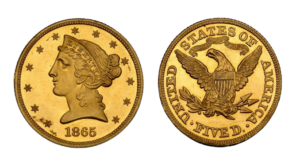4 Unique Pattern Coins Housed at the Smithsonian
Posted on- 5 Dollars, Pattern, United States, 1865
- 50 Dollars, Pattern, United States, 1877 – The “Half Union”
- 50 Cents, Pattern, United States, 1891
- 5 Cents, Pattern, United States, 1913 – The Buffalo Nickel
The Smithsonian is the largest museum complex on the planet. The United States’ treasured National Numismatic Collection lives within this impressive center at the Smithsonian’s National Museum of American History in Washington D.C.
The National Numismatic Collection includes roughly 1.6 million monetary objects and is believed to be the biggest money collection in the entire world and is unrivaled in its extraordinary collections. Many of its legendary coins are rarely seen.
Some of our nation’s most unique and celebrated pattern coins are protected at the Smithsonian for current and future generations. Pattern coins are those in which the design is struck for the purpose of evaluation only. If the design is approved, only then will the coin be produced for circulation.
All four of the below historic rarities are nestled among the greatest numismatic treasures in the Smithsonian collection in our nation’s capital. Let’s take a look.
1) $5 Dollar, Pattern, United States, 1865

Christian Gobrecht designed the stunning 1865 Half Eagle Gold $5 pattern coin. The obverse features the Lady Liberty facing left. She wears a coronet inscribed LIBERTY. Thirteen stars encircle the coin with the date: 1865 below the bust. The reverse showcases a dramatic eagle with its wings stretched wide with a protective shield covering its breast. The eagle carries three arrows and an olive branch with its talons. The motto IN GOD WE TRUST is on a scroll above the eagle’s head. Only two examples of this pattern were struck and one of them is housed at the Smithsonian.
2) $50 Dollar, Pattern, United States, 1877 – The “Half Union”

The gold rush in California prompted San Francisco business leaders to lobby congress for gold pieces with high denominations so bankers could quickly count the coins. There were more U.S. pattern coins produced in 1877 than any other year in American history!
Chief Engraver of the mint at the time, William Barber, designed the 1877 $50 Gold Pattern Coin, which is the largest U.S. pattern coin ever struck. This legendary coin was never struck for circulation and the pattern is safely ensconced at the Smithsonian museum for posterity.
3) 50-Cent, Pattern, United States, 1891

Charles E. Barber, the sixth chief engraver at the U.S. Mint, designed some of America’s most famous and best-loved coins. Barber worked at the U.S. Mint from 1879 to 1917, where he created numerous patterns including two unique 50-Cent Pattern coins in 1891, which are both housed at the Smithsonian’s National Museum of American History.
On the first 50-cent pattern, the obverse features a Capped head of Liberty facing right encircled by stars with the date below. The reverse highlights an Eagle, with stars and clouds above, encircled by an elaborate wreath. On the second 50 cent pattern, the obverse features a full length Lady Liberty facing left, with an imposing Eagle in the background. Rays are seen on the top half of the coin radiating from the center. Notably, some called Barber’s design “cluttered.”
4) 5-Cent, Pattern, United States, 1913 – The Buffalo Nickel

The 1913 Indian Head 5-cent piece pattern is a beloved rarity in the numismatic community, fondly known as the “Buffalo nickel.” Designed by James E. Fraser, the magnificent design on the reverse is instantly recognizable right-facing profile of a Native American man, with a Buffalo on the reverse with UNITED STATES OF AMERICA around the top and FIVE CENTS at bottom.
The memorable Buffalo nickel design was almost abandoned amid protests from the American vending machine industry, who thought the coin wouldn’t work within their machines properly. Fortunately, their concerns were unfounded. The Philadelphia Mint produced this arresting pattern coin in 1913 and while it is currently not on view, it is stored safely at the Smithsonian Museum.
Want to read more? Subscribe to the Blanchard Newsletter and get our tales from the vault, our favorite stories from around the world, and the latest tangible assets news delivered to your inbox weekly.









